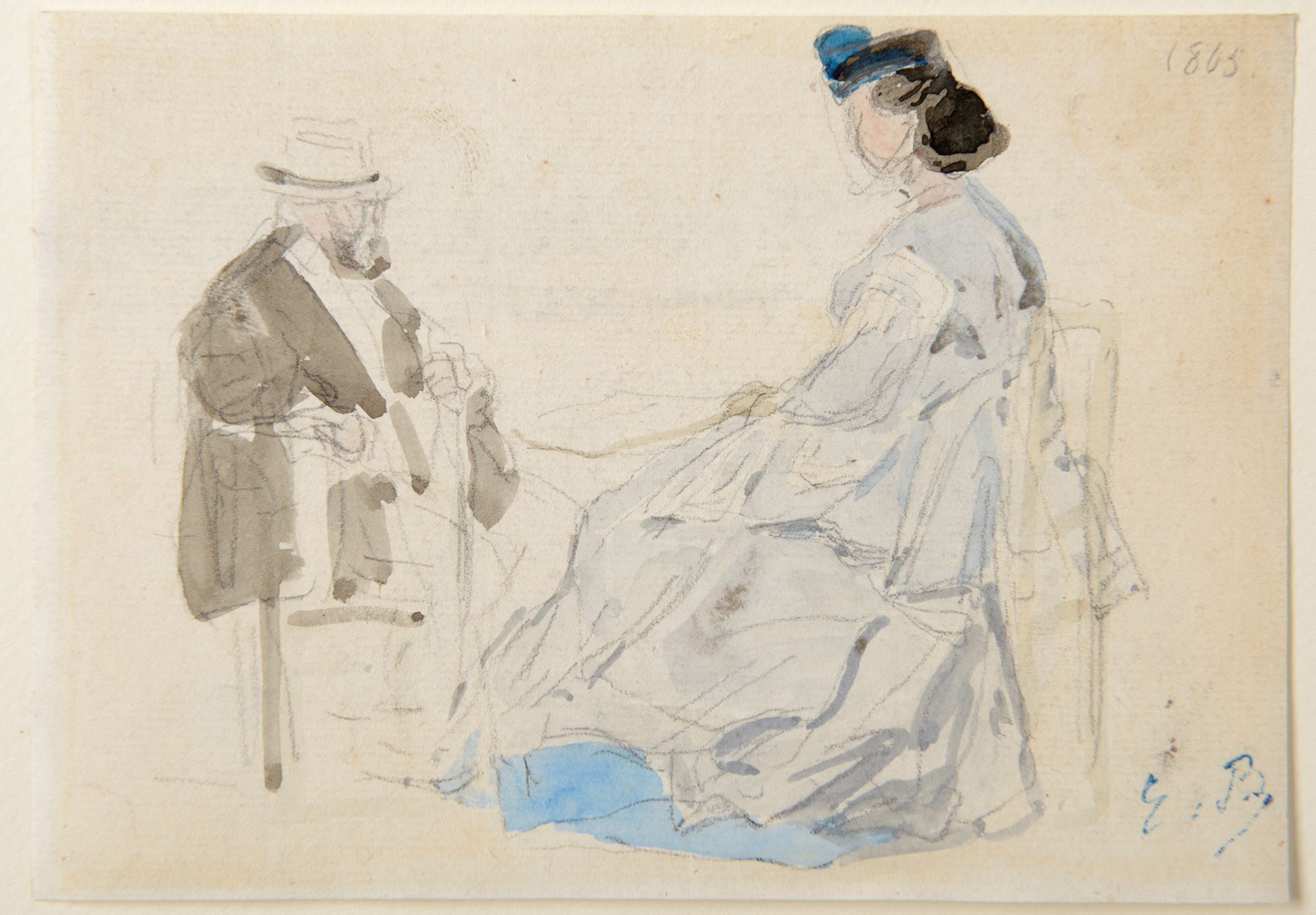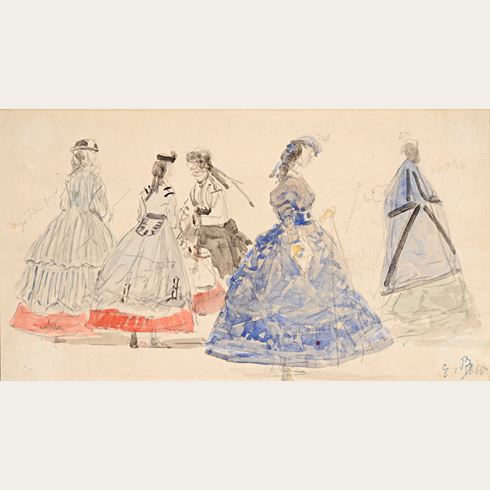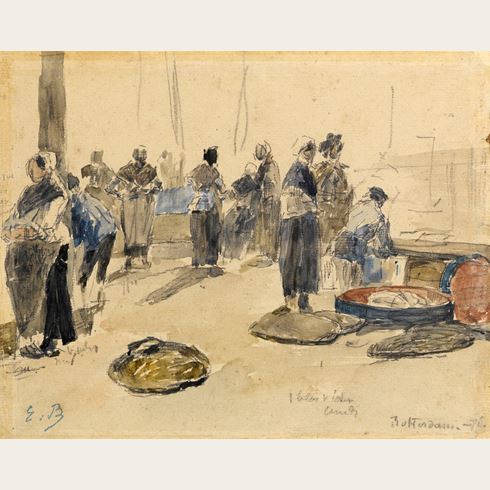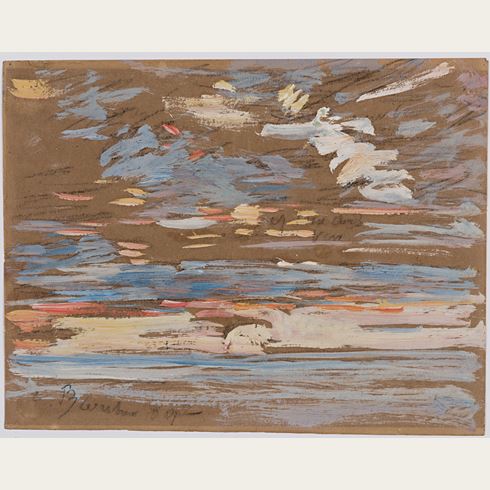Eugène BOUDIN
(Honfleur 1824 - Deauville 1898)
Study of a Seated Woman and Man on a Beach
Sold
Watercolour, over an underdrawing in pencil.
A sketch of a coastal view and a pair of legs in pencil on the verso.
Stamped with the atelier stamp E.B. (Lugt 828) at the lower right and dated 1865 at the upper right.
Numbered 9 on the verso.
104 x 148 mm. (4 1/8 x 5 3/4 in.)
A sketch of a coastal view and a pair of legs in pencil on the verso.
Stamped with the atelier stamp E.B. (Lugt 828) at the lower right and dated 1865 at the upper right.
Numbered 9 on the verso.
104 x 148 mm. (4 1/8 x 5 3/4 in.)
Throughout his career, Eugène Boudin was drawn to the seaside resort towns of Trouville and Deauville, on the Normandy coast. South of Le Havre and originally a fisherman’s village, Trouville had been transformed into a resort destination around 1848. With the opening of rail connections in 1860, the town oversaw a spurt in growth to accommodate the crowds of bourgeoisie who flocked to the seaside from Paris and elsewhere, with the establishment of luxury hotels, villas, casinos and a racecourse. Boudin rented a house in Trouville each summer and painted countless pictures of people on its beaches, as well as views of the quay, the fish market and the outskirts of the town.
Boudin’s depictions of elegant city dwellers as holidaymakers on the beach of Trouville, with a particular emphasis on fashionable women in crinoline dresses, date mainly from the 1860s. Although it has the appearance of a quick sketch, a small dated watercolour such as this may also have been intended as an independent work of art. Many of Boudin’s watercolours of beach scenes were sold to collectors - mainly during a period of seven years in the 1860’s – and in fact only a few studies of this type were left in his studio at his death. A handful of comparable sketches are among the large group of drawings by the artist in the Louvre, while similar watercolours are in the Musée d’Art Moderne André Malraux in Le Havre. Also very similar is a small watercolour in the Statens Museum for Kunst in Copenhagen, which was once part of a sketchbook by Boudin acquired by the couturier Edouard Molyneux, and from which he would remove drawings to give as presents.
Boudin’s depictions of elegant city dwellers as holidaymakers on the beach of Trouville, with a particular emphasis on fashionable women in crinoline dresses, date mainly from the 1860s. Although it has the appearance of a quick sketch, a small dated watercolour such as this may also have been intended as an independent work of art. Many of Boudin’s watercolours of beach scenes were sold to collectors - mainly during a period of seven years in the 1860’s – and in fact only a few studies of this type were left in his studio at his death. A handful of comparable sketches are among the large group of drawings by the artist in the Louvre, while similar watercolours are in the Musée d’Art Moderne André Malraux in Le Havre. Also very similar is a small watercolour in the Statens Museum for Kunst in Copenhagen, which was once part of a sketchbook by Boudin acquired by the couturier Edouard Molyneux, and from which he would remove drawings to give as presents.
The son of a sailor, Louis-Eugène Boudin established a small stationery and framing shop in the port city of Le Havre. Encouraged by some of the artists living or working in the area, whose work he sometimes exhibited in his shop, he took up painting himself in 1847. By the early 1850’s he had established a modest career as a landscape painter, working in Le Havre, Rouen, Honfleur and Paris. Praised by contemporaries such as the critic Charles Baudelaire, Boudin began painting marine scenes that attracted much favourable comment when he began exhibiting regularly at the Salon from 1859 onwards. He travelled extensively around France, Belgium and the Netherlands, and made yearly visits to favourite sites in Normandy and Brittany, in particular the fashionable seaside resorts of Deauville and Trouville. Much of Boudin’s work was small in scale, and was shown both in Paris and in provincial exhibitions around the country. He found a ready market for his paintings and, from 1881 onwards, enjoyed a fruitful relationship with the dealer Paul Durand-Ruel, who sold his works in France and in America.
Boudin's paintings and lively watercolours, with their interest in capturing effects of light and colour, were an important early influence on Claude Monet, who was his pupil. Some six thousand drawings, watercolours and oil sketches – most of the contents of Boudin’s studio at his death - are today in the Louvre, while other significant groups of drawings and watercolours were given by the artist or his descendants to the museums of Le Havre and Honfleur.
Provenance
The studio of the artist, with the atelier stamp E.B. (Lugt 828) at the lower right
Probably the Boudin atelier sale, Paris, Hôtel Drouot, 20-21 March 1899.










